Durst F. Fluid Mechanics: An Introduction to the Theory of Fluid Flows
Подождите немного. Документ загружается.


15.7 The Slow Rotational Motion of a Cylinder 451
is compared with the pressure term:
∂P
∂r
θ=0
=3µ
U
∞
R
r
3
, (15.127)
i.e. put in relation to one another:
ρ
DU
1
Dt
θ=0
∂P
∂r
θ=0
=
U
∞
r
2ν
1 −
R
2
r
2
1 −
3R
2r
+
R
3
2r
3
. (15.128)
For large values of r, this relationship shows that the above solution should
be valid only when U
∞
r/2ν<1 holds, i.e. for large values of r the requested
condition for the validity of the solution is not fulfilled. As, however, for such
large values for r, the terms that have been employed above, for order of
magnitude considerations, become very small, it is justified to assume that
the velocity and pressure fields in the immediate proximity of the sphere are
not affected by influences of the introduced assumption for the validity of
the obtained solution. In order to achieve the derived solution in a reliable
way, it had to be assumed, however, that (U
∞
R)/ν 1. On the basis of
such considerations, it can be assumed that the Stokes solution already does
not hold any longer for the flow around a sphere for Re ≈ 1, i.e. when
Re =(U
∞
D/ν) ≈ 1. It is a solution for Re < 1.
15.7 The Slow Rotational Motion of a Cylinder
Analogous to the discussion of the slowly rotating flow around a sphere in
Sect. 15.5, the rotating cylinder flow will be discussed in this section. Here, the
flow which occurs in the annular clearance between two concentric rotating
cylinders, with radii R
1
and R
2
, will be investigated. This flow is described
by the equations that are stated below and which, assuming
∂U
ϕ
∂ϕ
=0 and U
ϕ
= U
ϕ
(r) (15.129)
can be derived from the general basic equations of fluid mechanics written in
cylindrical coordinates:
ρ
U
2
ϕ
r
=
∂P
∂r
=
dP
dr
(15.130)
and
d
2
U
ϕ
dr
2
+
d
dr
U
ϕ
r
=0. (15.131)
These are the differential equations for the pressure P and the flow velocity
U
ϕ
. From (15.131), one obtains by integration:

452 15 Fluid Flows of Small Reynolds Numbers
dU
ϕ
dr
+
U
ϕ
r
=2C
1
=
1
r
d
dr
(rU
ϕ
) . (15.132)
By further integration, one obtains:
U
ϕ
= C
1
r +
C
2
r
(15.133)
with the integration constants C
1
and C
2
. These can be determined from the
boundary conditions:
r = R
1
; U
ϕ
= ω
1
R
1
and r = R
2
; U
ϕ
= ω
2
R
2
, (15.134)
i.e. the following equations hold for C
1
and C
2
:
ω
1
R
1
= C
1
R
1
+
C
2
R
1
and ω
2
R
2
= C
2
R
2
+
C
2
R
2
(15.135)
and thus
C
1
= ω
1
+
R
2
2
(R
2
2
− R
2
1
)
(ω
2
+ ω
1
) (15.136a)
C
2
=
R
2
1
R
2
2
(R
2
2
− R
2
1
)
(ω
2
+ ω
1
) . (15.136b)
Inserting C
1
and C
2
in (15.133), one obtains:
U
ϕ
=
1
(R
2
2
− R
2
1
)
!
ω
2
R
2
2
− ω
1
R
2
1
"
r −
R
2
1
R
2
2
r
2
(ω
2
− ω
1
)
. (15.137)
By means of (15.137), one obtains by integration from (15.130) for the
pressure distribution in the annular clearance:
P (r)=P
1
+
ρ
(R
2
2
− R
2
1
)
2
!
ω
2
R
2
2
− ω
1
R
2
1
"
2
r
2
− R
2
1
2
− 2R
2
1
R
2
2
(ω
2
− ω
1
)
!
ω
2
R
2
2
− ω
1
R
2
1
"
ln
r
R
1
−
R
4
1
R
4
2
2
(ω
2
− ω
1
)
1
r
2
−
1
R
2
1
.
(15.138)
The pressure at the internal cylinder wall was introduced in (15.138) with P
1
,
in order to determine the constant resulting from the integration of (15.130).
For the pressure distribution along the periphery of the external cylinder,
one can compute from (15.138)
P (R
2
)=P
1
+
ρ
(R
2
2
− R
2
1
)
2
!
ω
2
R
2
2
− ω
1
R
2
1
"
2
R
2
2
− R
2
1
2
− 2R
2
1
R
2
2
(ω
2
− ω
1
)
!
ω
2
R
2
2
− ω
1
R
2
1
"
ln
R
2
R
1
−
R
4
1
R
4
2
2
(ω
2
− ω
1
)
1
R
2
2
−
1
R
2
1
.
(15.139)

15.8 The Slow Translatory Motion of a Cylinder 453
For the molecular momentum transport, the following relationship holds:
τ
rϕ
= −µ
r
d
dr
U
ϕ
r
. (15.140)
With the aid of the solution (15.137) for U
ϕ
, one can compute
τ
rϕ
=
−2µ
(R
2
2
− R
2
1
)
R
2
1
R
2
2
r
2
(ω
2
− ω
1
) . (15.141)
The molecular-dependent momentum input into the internal cylinder amo-
unts to
τ
rϕ
(r = R
1
)=
−2µ
(R
2
2
− R
2
1
)
R
2
2
(ω
2
− ω
1
) (15.142)
and for the external cylinder to
τ
rϕ
(r = R
2
)=
−2µ
(R
2
2
− R
2
1
)
R
2
1
(ω
2
− ω
1
) . (15.143)
The circumferential forces acting on the cylinder can therefore be computed
as follows:
Fr(r = R
1
)=τ
rϕ
(r = R
1
)2πR
1
L = F
1
F
ϕ
(r = R
2
)=τ
rϕ
(r = R
2
)2πR
2
L = F
2
.
(15.144)
From the relationships for the forces, one can see that the resulting circum-
ferential forces are directly proportional to the viscosity, a fact which is used
in the production of viscosimeters to measure the viscosities of fluids.
15.8 The Slow Translatory Motion of a Cylinder
The considerations carried out at the end of Sect. 15.6 show that perform-
ing fluid-flow computations with induced simplifications into basic equations,
can lead to solutions for which, in some subdomains of the flow field, the as-
sumptions made for the simplifications are no longer valid. This fact has
resulted in some regions for the Stokes solution of the flow around a sphere,
e.g. in regions where U
∞
r/ν ≥ 1. In these regions far away from the sphere,
the Reynolds number of the flow becomes too large. There, the acceleration
terms, neglected in the Stokes solution ansatz, prove to be no longer small
in comparison with the considered pressure terms. Basically, unsatisfactory
argumentations had to be used to justify the validity of the obtained solution.
Strictly, only experimental investigations for determining the drag force on
the sphere could confirm the correctness of the argumentation.
The problematic nature shown for the flow around a sphere becomes even
clearer when one looks at the corresponding cylindrical problem, i.e. the
two-dimensional flow around a cylinder. It shows indeed that for the plane
flow around a cylinder of a viscous fluid no solution at all can be found by
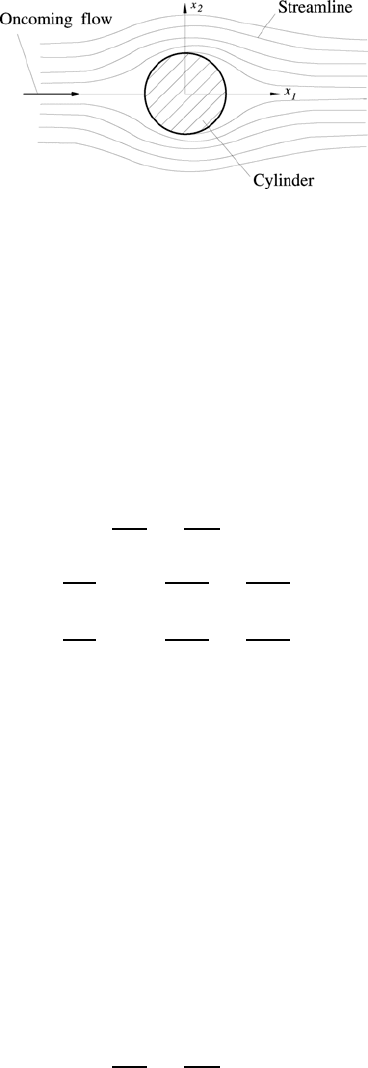
454 15 Fluid Flows of Small Reynolds Numbers
Fig. 15.9 Diagram of the flow around a cylinder
employing the differential equations (15.4) or (15.6) and (15.7) or (15.8)–
(15.11). It is thus very problematic not to employ the complete set of basic
equations when solving flow problems, but to use reduced sets of differential
equations. The latter approach is, however, often necessary for the reason
that analytical solutions for the complete set of the basic equations are not
available.
For the flow around a cylinder, shown in Fig. 15.9, the following differential
equations hold, when assuming a flow possessing a small Reynolds number,
i.e. to postulate the validity of the Stokes equations:
∂U
1
∂x
1
+
∂U
2
∂x
2
= 0 (15.145)
∂P
∂x
1
= µ
∂
2
U
1
∂x
1
2
+
∂
2
U
1
∂x
2
2
(15.146)
∂P
∂x
2
= µ
∂
2
U
2
∂x
1
2
+
∂
2
U
2
∂x
2
2
(15.147)
with the boundary conditions:
U
1
= U
2
=0 for r = R (15.148)
U
1
= U
∞
,U
2
=0 for r →∞. (15.149)
The analytical solution that can now be determined for the above differen-
tial equations, proves to be of a form such that the boundary conditions
introduced for r = R and r →∞lead to two solutions that contradict one
another. Thus, it is consequently not possible to solve the simplified flow
equations (15.145)–(15.147), in which the acceleration terms were neglected,
for the boundary conditions stated in (15.148) and (15.149). This insight
into the problem suggests leaving the acceleration terms in the basic equa-
tions. For the plane problem of the flow around a cylinder, for ρ = constant
and stationary flow conditions, one obtains the following set of differential
equations:
∂U
1
∂x
1
+
∂U
2
∂x
2
= 0 (15.150)

15.8 The Slow Translatory Motion of a Cylinder 455
ρ
U
1
∂U
1
∂x
1
+ U
2
∂U
1
∂x
2
= −
∂P
∂x
1
+ µ
∂
2
U
1
∂x
1
2
+
∂
2
U
1
∂x
2
2
(15.151)
ρ
U
1
∂U
2
∂x
1
+ U
2
∂U
2
∂x
2
= −
∂P
∂x
2
+ µ
∂
2
U
2
∂x
1
2
+
∂
2
U
2
∂x
2
2
. (15.152)
With U
1
= U
∞
+ u
1
and U
2
= u
2
, the following set of equations results,
assuming U
∞
u
1
to yield the generalized Stokes equations:
∂u
1
∂x
1
+
∂u
2
∂x
2
= 0 (15.153)
ρU
∞
∂u
1
∂x
1
= −
∂P
∂x
1
+ µ
∂
2
u
1
∂x
1
2
+
∂
2
u
1
∂x
2
2
(15.154)
ρU
∞
∂u
2
∂x
2
= −
∂P
∂x
2
+ µ
∂
2
u
2
∂x
1
2
+
∂
2
u
2
∂x
2
2
. (15.155)
Introducing the potential function φ(x
1
,x
2
), one obtains with
∂
2
φ
∂x
i
2
=0,
according to a solution path proposed by Lamb (1911), the following ansatz
for u
1
and u
2
:
u
1
=
∂φ
∂x
1
+
1
2k
∂χ
∂x
1
− χ and u
2
=
∂φ
∂x
2
+
1
2k
∂χ
∂x
2
, (15.156)
where the quantities φ and χ fulfil the following differential equations:
∂
2
φ
∂x
1
2
+
∂φ
∂x
2
=0 and
∂
2
χ
∂x
1
2
+
∂
2
χ
∂x
2
2
− 2k
∂χ
∂x
1
=0. (15.157)
Equations (15.153)–(15.155) are all fulfilled, when one inserts for the pressure:
P = P
∞
− ρU
∞
∂φ
∂x
1
. (15.158)
For φ(x
1
,x
2
), the following ansatz can be found, in order to fulfil the
differential equation (15.157):
φ = A
0
ln r + A
1
∂ ln r
∂x
1
+ A
2
∂
2
ln r
∂x
1
2
+ ··· . (15.159)
For χ(x
1
,x
2
), one introduces:
χ = ψ exp(kx
1
) (15.160)
so that for the determination of ψ the following differential equation results:
∂
2
ψ
∂x
1
2
+
∂
2
ψ
∂x
2
2
− k
2
ψ = 0 (15.161)

456 15 Fluid Flows of Small Reynolds Numbers
or in cylindrical coordinates:
∂
2
ψ
∂r
2
+
1
r
∂ψ
∂r
+
1
r
2
∂
2
ψ
∂ϕ
2
− k
2
ψ =0. (15.162)
On now looking for the solution of this equation, which depends on r,one
obtains the following ordinary differential equation:
d
2
φ
dr
2
+
1
r
dφ
dr
− k
2
φ =0. (15.163)
This differential equation is determined by the Bessel function K
0
(kr)and
its derivatives, so that the following ansatz seems reasonable:
χ = −U
∞
+exp(kx)
B
0
K
0
(kr)+B
1
∂K
0
(kr)
∂x
1
+ B
2
∂
2
K
0
(kr)
∂x
1
2
+ ···
.
(15.164)
Because
∂(ln r)
∂x
1
=
x
1
r
2
=
cos ϕ
r
and
∂
2
ln r
∂x
1
2
= −
cos 2θ
r
2
(15.165)
it can be derived that:
φ = A
0
ln r + A
1
cos ϕ
r
− A
2
cos 2ϕ
r
2
. (15.166)
For the function χ one can write, on introducing the Mascheroni constant,
γ = 1.7811 or ln γ = 0.57722:
χ = −U
∞
− B
0
ln
γ
2
kr
+ kr cos ϕ ln
γ
2
kr
− B
1
cos ϕ
r
(15.167)
so that for the velocity field in cylindrical coordinates one can write:
U
r
(r, ϕ)=
A
0
r
−
A
1
cos ϕ
r
2
+ U
∞
cos ϕ − B
0
1
2kr
+
1
2
cos ϕ (15.168)
−
1
2
cos ϕ ln
γ
2
kr
+ B
1
cos ϕ
2kr
2
U
ϕ
(r, ϕ)=−
A
1
sin ϕ
r
2
− U
∞
sin ϕ − B
0
sin ϕ
2
ln
γ
2
kr
+
B
1
sin ϕ
2kr
2
. (15.169)
Including the boundary conditions for r = R,oneobtains:
A
0
R
−
B
0
2kR
=0 ; A
0
=
B
0
2k
(15.170)
A
1
R
2
+ U
∞
−
B
0
2
1 − ln
γ
k
kR
+
B
1
2kR
2
= 0 (15.171)
−
A
1
R
2
− U
∞
−
B
0
2
ln
γ
2
kR
+
B
1
2kR
2
=0. (15.172)
Thus, one obtains for the integration constants:
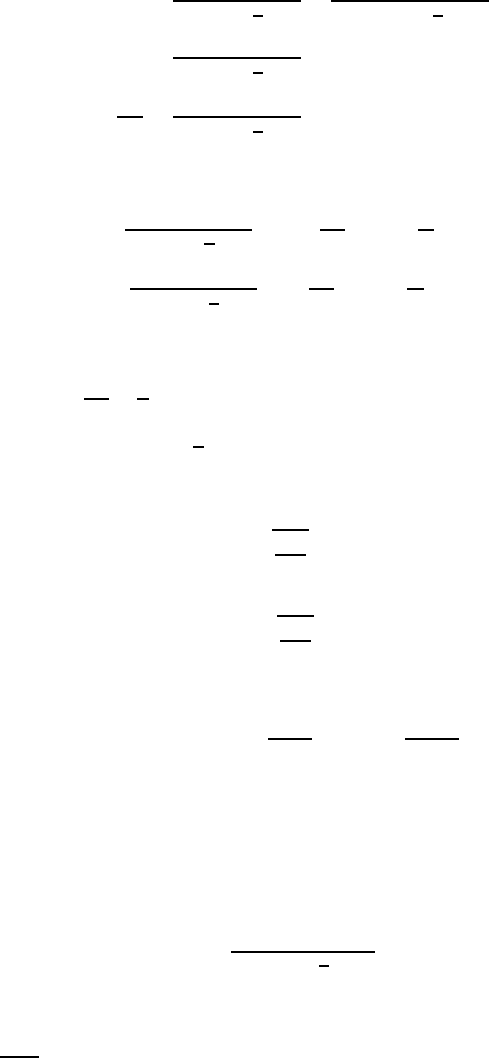
15.8 The Slow Translatory Motion of a Cylinder 457
A
0
=
4ν
1 − 2ln
!
γ
2
kR
"
=
2U
∞
k
7
1 − 2ln
!
γ
2
kR
"8
(15.173)
B
0
=
4U
∞
1 − 2ln
!
γ
2
kR
"
(15.174)
A
1
−
B
1
2k
=
−U
∞
R
2
1 − 2ln
!
γ
2
kR
"
. (15.175)
This yields for the velocity components in proximity of the cylinder:
U
r
(r, ϕ)=
U
∞
cos ϕ
1 − 2ln
!
γ
2
kR
"
−1+
R
2
r
2
+2ln
r
R
(15.176)
U
ϕ
(r, ϕ)=
−U
∞
sin ϕ
1 − 2ln
!
γ
2
kR
"
1 −
R
2
r
2
+2ln
r
R
. (15.177)
For large distances the following equations hold for the velocity components:
U
r
(r, ϕ)=
A
0
r
+
1
2
B
0
exp (kr cos ϕ)[K
0
(kr) − cos ϕK
0
(kr)] (15.178)
U
ϕ
(r, ϕ)=
1
2
B
0
exp (kr cos ϕ) K
0
(kr)sinϕ, (15.179)
where for large arguments (kr) the following asymptotic relationships hold:
K
0
(kr) ≈
0
π
2kr
exp(−kr) (15.180)
and
K
0
(kr) ≈−
0
π
2kr
exp(−kr). (15.181)
The pressure can be computed as:
P = P
∞
− ρU
∞
A
0
cos ϕ
r
+ ρU
∞
A
1
cos 2ϕ
r
2
. (15.182)
For the drag force, the following equation results:
F
D
=2πρU
∞
A
0
. (15.183)
When A
0
is inserted, the Lamb equation for the drag force per unit length
of a cylinder results:
F
D
=
8πµU
∞
7
1 − 2ln
!
γ
2
kR
"8
. (15.184)
Although the acceleration terms are taken into consideration, the above
relation for F
D
, i.e. (15.184), can only be employed for small values for
Re =
U
∞
R
ν
< 1.
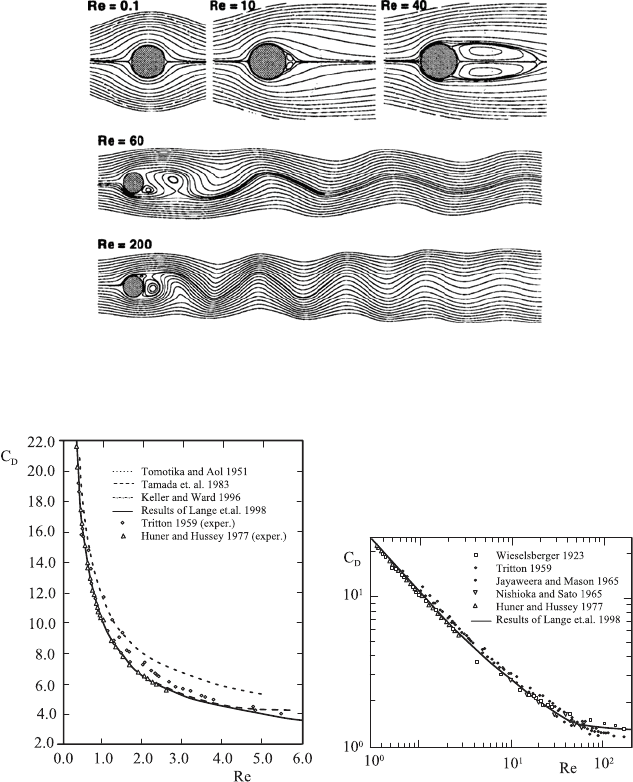
458 15 Fluid Flows of Small Reynolds Numbers
Fig. 15.10 Stream lines for flows around a cylinder at different Reynolds numbers
Fig. 15.11 Drag coefficients for the flows around cylinders
If one does not want to have the above limitations of the derived solution
of the considered flow problem, i.e. if one seeks a solution without any re-
strictions for the flow around a cylinder, one has to solve the complete set of
equations numerically. Such solutions are nowadays possible for Re ≤ 10.000
by direct solutions of the continuity and Re−equations. They lead to the
results shown in Fig. 15.10 for the stream lines of the flows. In Fig. 15.11, so-
lutions for the drag coefficient of fluid flows for small Reynolds numbers are
shown. Fluid flows information for small Re−number flows around spheres
are provided in Fig. 15.12.
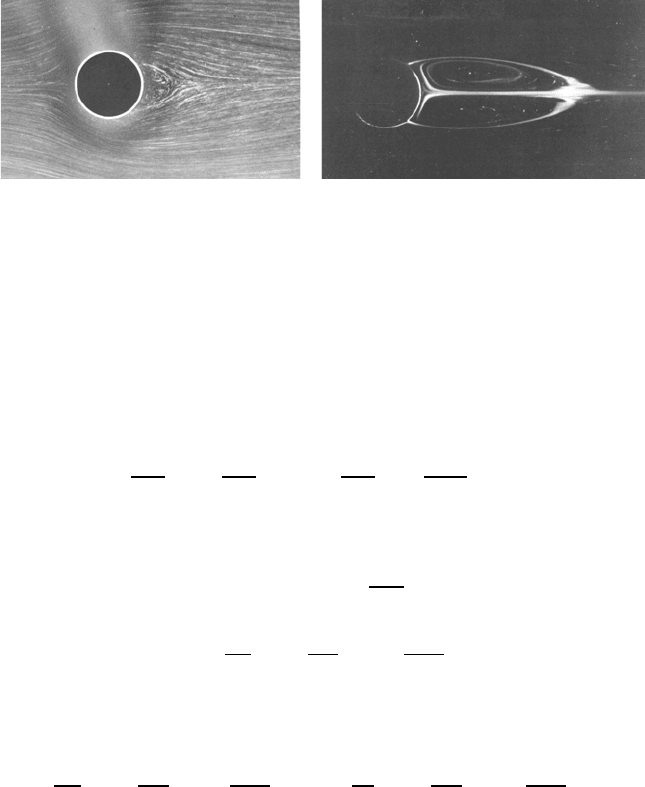
15.9 Diffusion and Convection Influences on Flow Fields 459
Fig. 15.12 Recirculating flow regions behind spheres, from the book of Van Dyke
[15.8]
15.9 Diffusion and Convection Influences on Flow Fields
In paragraphs 3 and 5 the analogy of heat conduction and molecular momen-
tum transport is underlined and, in order to emphasize the significance of
this analogy, the general form of the momentum equations was transformed
into the transport equation for vorticity (see Chap. 5):
ρ
∂ω
j
∂t
+ U
i
∂ω
j
∂x
i
= ρω
j
∂U
j
∂x
i
+ µ
∂
2
ω
j
∂x
i
2
. (15.185)
For the two-dimensional flow around a cylinder, ω
3
= ω is the only compo-
nent which is unequal to zero, and this fact allows one to write the vorticity
equation as a scalar equation. Because ρω
i
∂U
j
∂x
i
= 0, this equation reads:
ρ
∂ω
∂t
+ U
i
∂ω
∂x
i
= µ
∂
2
ω
∂x
i
2
. (15.186)
On comparing this equation with the heat or mass transport equations for
convective and diffusive transport:
ρc
v
∂T
∂t
+ U
i
∂T
∂x
i
= λ
∂
2
T
∂x
i
2
and ρ
∂c
∂t
+ U
i
∂c
∂x
i
=D
∂
2
c
∂x
i
2
. (15.187)
one sees that one can understand the influence of walls on flows in such a way,
that at the boundary of the body the vorticity ω is produced. The vorticity
is then transported from the body to the fluid, by molecular diffusion, into
the moving fluid, see Fig. 15.13.
In order to understand now the interaction between convection and diffu-
sion, it is thus possible to consider the diffusive and convective heat transport,
and to transfer the insight gained in this way to the vorticity and its transport
in the flow field.
On considering a heated cylinder with a small diameter when a sudden
temperature increase takes place, it can be seen that in a time ∆t,aheat
front dissipates as follows, due to heat conduction:
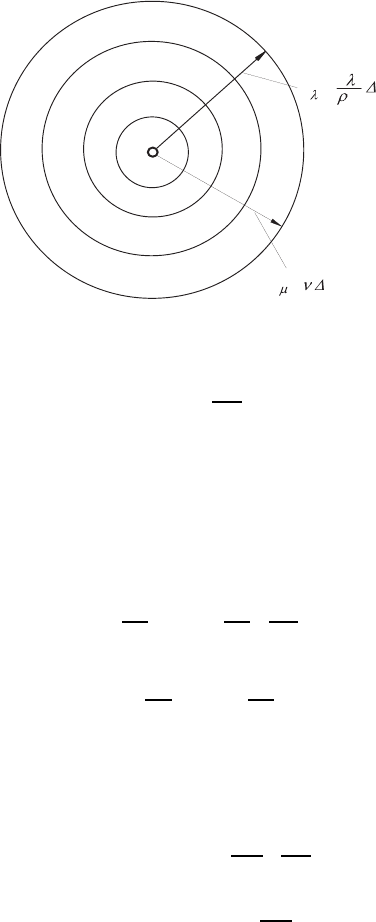
460 15 Fluid Flows of Small Reynolds Numbers
R ~
t
c
p
2
R ~
t
2
Expansion
of
heat
Expansion
of
vorticity
Fig. 15.13 Spreading of head and momentum by diffusion only
R
2
λ
=const
λ
ρc
v
∆t, (15.188)
where R
λ
is a measure of the radial propagation, the heat has moved in the
time ∆t. For the vorticity one can write in an analogous way
R
2
µ
=constν ∆t. (15.189)
For the diffusion velocity one thus obtains:
u
λ
=
R
λ
∆
t
=const
1
R
λ
λ
ρc
v
(15.190)
or
u
µ
=
R
µ
∆
t
=const
1
R
µ
ν. (15.191)
When a fluid now moves convectively at a small flow velocity U
1
= U
∞
,
the state illustrated in Fig. 15.14 results, which is characterized by the fact
that a point can be found on the x
1
axis, at which the dissipation velocity is
U
µ
= U
∞
,sothat
(x
1
)
λ
= R
λ
=const
1
U
∞
λ
ρc
v
(15.192)
or
(x
1
)
µ
= R
µ
=const
ν
U
∞
. (15.193)
With this it can be understood that in the presence of an inflow the influence
of the cylinder on the temperature or velocity field can have an effect in a
limited area only, as Fig. 15.14 shows. To the right of point (x
1
)
µ
, there is no
information at all about the body lying in Fig. 15.14. The insights explained
in Fig. 15.14 are important when one has to find in the inflow domain of a
